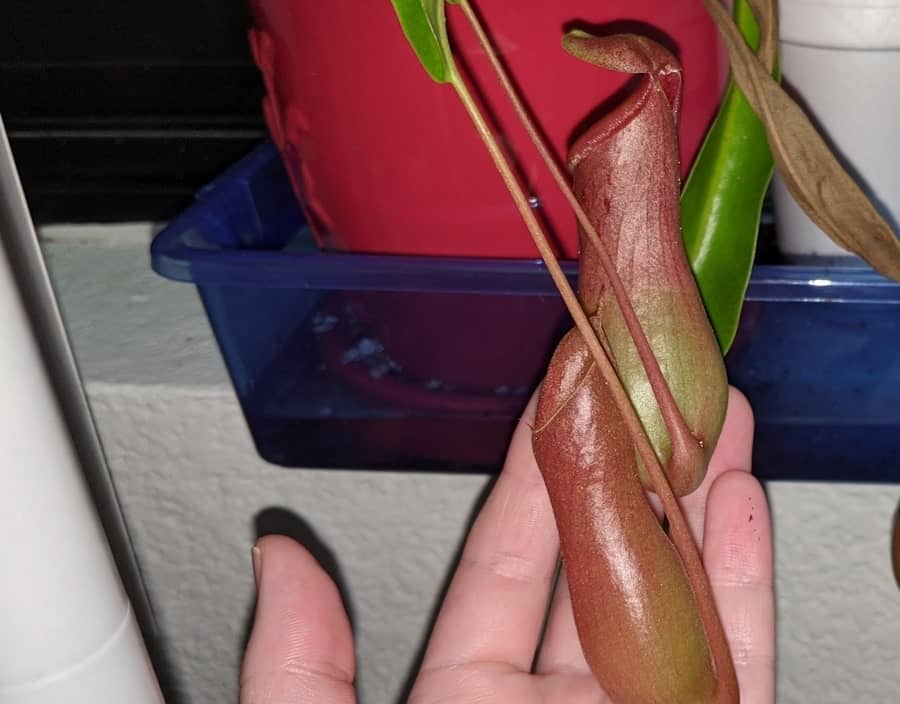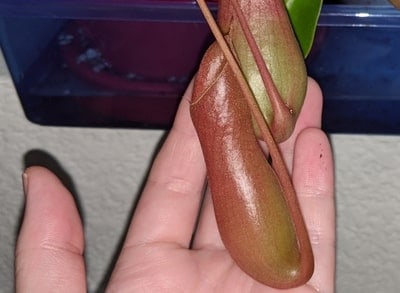Pitcher plants should have open pitchers ready to capture insects. But, in some instances, these plants keep their pitchers closed.
Pitcher plants close their lids due to insufficient humidity, improper temperature, dry soil, or other related factors. The growing habitat must be adjusted to encourage the pitchers to open back up. Open pitchers are ready to capture bugs and allow the consumption of valuable nutrients.
Close lids are commonly due to improper growing conditions, which can weaken and eventually kill your plant. This article will solve your doubts about why your pitcher plant is closed and teach you how to fix it.

The pitcher plant is considered one of the largest and most striking carnivorous plants in the world. It has large, jar-shaped leaves, which serve to trap and digest small organisms. These death traps hang from spiral-shaped tendrils and are filled with acidic gastric juices. To prevent the digestive liquid from being diluted by rainwater and losing concentration, the trap has a small lid that protects the pitcher.
One of the headaches that growing Pitcher plants can bring us may be that the traps of our pitcher plant are closed. In this article, we will explore key care considerations to solve this problem.
Keep in mind that there are many types of pitcher plants with different requirements. Knowing which kind of pitcher plant you own is useful to assess their needs.
Within pitcher plants, there are different varieties. The most commons are:
- Nepenthes Lowland: They endure temperatures from 25 C to 35 C, as long as their leaves are damp. These are characterized by being a little smaller and broader. Like most varieties of this species, it is brightly colored.
- Nepenthes Howland: Like Nepenthes Lowland, its leaves must be moist at all times. The range of temperatures that it can withstand is a little wider since it can withstand temperatures between 15 C and 30 C. This plant has a reddish hue and can reach a larger size than the previous one.
- Nepenthes Highland: Withstands temperatures from 10 C to 20 C. Physically they are very long and not very wide; they have an opaque hue.
Why Are Pitcher Plants Closed?
Pitcher plants have structures that resemble a “lid” over each pitcher. The lid can serve as protection from rain and the evaporation of its gastric juices. The top usually remains separate and does not close the pitcher completely. Three main problems cause closed pitchers:
- Lack of humidity: This is another of the main problems. Carnivorous plants, in general, need adequate environmental humidification. In this particular species, a humidity of even 75% is recommended.
- Dry soil: as in most carnivorous plants, they need reasonably moist soil to develop their roots.
- Keep them at an inappropriate temperature: something that also affects our pitcher plant and that many people overlook when they start in the world of gardening is the temperature at which we must maintain certain species, especially the most delicate ones. As we mentioned at the beginning of the article, there are different Nepenthes varieties, and each of them needs a specific temperature. If the weather at which we keep it is outside the range it can withstand, it could be why it is not opening its traps correctly.
How to Encourage a Pitcher Plant to Open?
The essential thing if your pitcher plant has its traps closed is to remain calm. We should not rush and try to find disproportionate solutions.
The most useful advice we can give you is to review all the environmental factors in which your carnivorous plant lives and determine if they are adequate or not.
To carry out this task, we must examine the three factors mentioned in the previous point, since the problem usually lies here in most cases.
Solution for Dry Soil
To know the first possible problem, which is the lack of humidity in the substrate, we must: touch the surface part of the substrate on which our pitcher plant sits, and if it is dry, it would mean that it does not have enough humidity. If this were our case, the best option would be to water it and start doing it more frequently. We remember that this species needs to be watered between every three and five days, depending on how hot it is in the place where we live. The soil must remain humid, but not damped and never dry.
For best results, make sure you use soil that provides aeration and retains moisture. This article can help you select the best soil for your pitcher plant.
Solution for Lack of Humidity
This point is somewhat more complicated to solve than the previous one since it refers to environmental humidity, but this does not mean that it is impossible. To know if this problem is the one that is causing the jars of our jar plant not to open, we must look at whether the other conditions are under control.
Some tricks that we can try to solve this problem could be:
- If our plant is located indoors (read the pitcher plant indoor care guide), a good option would be to purchase a humidifier and place it near it. Thanks to this device, we will be able to substantially increase the humidity in the air, thus favoring our plants in need of moisture.
- Another option to consider would be to keep it in a terrarium. We must keep this alternative in mind because, in addition to keeping humidity under control, we can also keep other variables such as temperature constant. In this case, we can increase the humidity inside the terrarium by introducing a humidifier or a dish with water to use the effects of evaporation to our advantage.
- The last and simplest trick to maintain adequate humidity for our pitcher plant would be to spray it manually. This alternative has its good part and its bad part. The good part is that we will increase the humidity substantially immediately. On the other hand, the bad part is that we will have to do it quite frequently, especially when the weather is hot.
Solution for Improper Temperature
Throughout this article, we have already mentioned the temperature necessary to care for this species in captivity depends on the variety we own since not all of them withstand the same temperatures. The tricks that we will mention in this section will serve equally for all varieties. You only have to adapt it to the variety to which your pitcher plant belongs.
The first option and the most comfortable in the long term would be to acquire the variety of pitcher plant that best suits the climate of the area in which we live. The benefits of making this decision are more than obvious. One of them is that we will not have to worry about adapting to the temperature that our carnivorous plant needs artificially.
If we have not taken this alternative, we must move our pitcher plant indoors when the climatic temperature is not within the range that the plant can withstand, either because it is too hot in summer or too cold in winter (it will depend on your plant’s variety).
Other Factors
Apart from these three factors, there are other more secondary factors. This does not mean that they do not play an important role in the development and correct functioning of our carnivorous plant’s system.
- One of these factors could be to use a suitable substrate. Pitcher plants thrive in nutrient-less soil with good aeration and drainage. A 1:1 mixture of peat or sphagnum moss with perlite or silica sand are suitable alternatives.
- Another critical point to keep in mind is that we should not make the mistake of adding some fertilizer. This action could damage our pitcher plant since they come from areas with soils poor in nutrients, and their roots are not adapted to absorb them. This is why they have adapted to be able to hunt insects and meet their needs to acquire nutrients.
- Another problem that we must rule out if we observe that our pitcher plant is closed is that it may have some type of infection caused by a pest. This will be of vital importance to save our plant from possible death.
Once your Pitcher plant starts opening, you can start feeding it (this guide can teach you how to feed your pitcher plant properly) (this guide can teach you how to feed your pitcher plant properly). This guide can help you learn which bugs to employ and how to do it: What To Feed a Pitcher Plant: A Comprehensive List (Plus Feeding Tips)
Adjusting the growing environment can make a huge difference in your plant’s health and allow the pitchers to open up. If you need more information on pitcher plant care, this article: A Complete Pitcher Plant Care Guide (with care sheet) will give you all the information you need.


